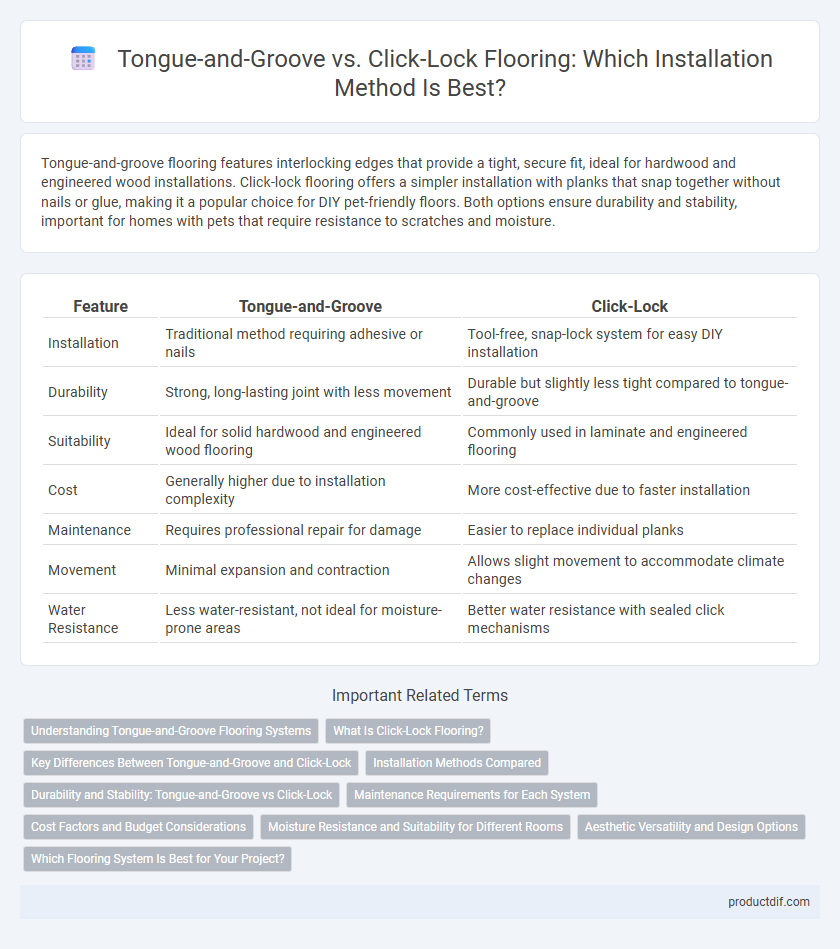Tongue-and-groove flooring features interlocking edges that provide a tight, secure fit, ideal for hardwood and engineered wood installations. Click-lock flooring offers a simpler installation with planks that snap together without nails or glue, making it a popular choice for DIY pet-friendly floors. Both options ensure durability and stability, important for homes with pets that require resistance to scratches and moisture.
Table of Comparison
| Feature | Tongue-and-Groove | Click-Lock |
|---|---|---|
| Installation | Traditional method requiring adhesive or nails | Tool-free, snap-lock system for easy DIY installation |
| Durability | Strong, long-lasting joint with less movement | Durable but slightly less tight compared to tongue-and-groove |
| Suitability | Ideal for solid hardwood and engineered wood flooring | Commonly used in laminate and engineered flooring |
| Cost | Generally higher due to installation complexity | More cost-effective due to faster installation |
| Maintenance | Requires professional repair for damage | Easier to replace individual planks |
| Movement | Minimal expansion and contraction | Allows slight movement to accommodate climate changes |
| Water Resistance | Less water-resistant, not ideal for moisture-prone areas | Better water resistance with sealed click mechanisms |
Understanding Tongue-and-Groove Flooring Systems
Tongue-and-groove flooring systems feature interlocking edges where a protruding tongue fits snugly into a corresponding groove, creating a tight and stable joint that enhances floor durability. This method requires precise installation, often involving glue or nails, ensuring minimal movement and increased resistance to moisture infiltration. Tongue-and-groove flooring is commonly used in hardwood and engineered wood floors, valued for its traditional craftsmanship and long-lasting structural integrity.
What Is Click-Lock Flooring?
Click-lock flooring is a type of floating floor installation system where planks securely snap together without the need for glue or nails, offering a fast and easy DIY process. The interlocking mechanism involves a ridge on one plank fitting into a groove on another, creating a tight, seamless fit that enhances stability and reduces gaps. Popular in laminate, engineered wood, and luxury vinyl planks, click-lock flooring provides durability, moisture resistance, and efficient installation compared to traditional tongue-and-groove systems.
Key Differences Between Tongue-and-Groove and Click-Lock
Tongue-and-groove flooring features boards with a protruding tongue on one edge and a corresponding groove on the other, requiring adhesive or nails for installation, ensuring a tight, seamless fit ideal for hardwood floors. Click-lock flooring utilizes interlocking edges that snap together without adhesives or nails, allowing for simpler, quicker installation and easy replacement, commonly found in laminate and engineered wood floors. The primary differences lie in installation methods, required tools, and suitability for various subfloors and room conditions.
Installation Methods Compared
Tongue-and-groove flooring requires each board to be manually fitted by inserting a protruding tongue into a corresponding groove, ensuring a tight, stable connection that often necessitates glue or nails for extra security. Click-lock flooring features interlocking planks that snap together easily without glue or nails, streamlining installation and allowing for floating floor setups that expand and contract naturally. The straightforward click-lock system typically reduces installation time and complexity, making it a preferred choice for DIY projects and floating subfloors.
Durability and Stability: Tongue-and-Groove vs Click-Lock
Tongue-and-groove flooring offers superior durability and stability due to its interlocking mechanism that requires adhesive, creating a solid and long-lasting bond resistant to movement and moisture. Click-lock flooring, while easier to install with its snap-together design, may experience slight shifts over time, especially in high traffic or uneven subfloor conditions. For long-term structural integrity, tongue-and-groove is generally preferred, providing enhanced resistance to wear and maintaining floor flatness across varied environments.
Maintenance Requirements for Each System
Tongue-and-groove flooring requires regular inspection to prevent moisture infiltration in seams, as it relies on tight joints that can swell or warp if exposed to water. Click-lock systems offer easier maintenance with floating planks that allow for better expansion and contraction, reducing the risk of damage due to humidity changes. Both systems benefit from routine cleaning, but click-lock floors typically need less attention to seam integrity over time.
Cost Factors and Budget Considerations
Tongue-and-groove flooring typically incurs higher installation costs due to the need for professional labor and adhesive application, making it less budget-friendly for DIY projects. Click-lock flooring offers a cost-effective alternative with easier, faster installation that reduces labor expenses and suits tight budgets. Material prices vary by species and finish, but overall, click-lock systems tend to minimize total project costs through lower installation complexity and time.
Moisture Resistance and Suitability for Different Rooms
Tongue-and-groove flooring provides a tight, interlocking fit that offers moderate moisture resistance, making it suitable for living rooms and bedrooms but less ideal for high-moisture areas. Click-lock flooring features a more advanced click-fit installation that enhances moisture resistance and makes it highly suitable for kitchens, bathrooms, and basements. Both options provide durability, but click-lock flooring's superior moisture barriers make it preferable for rooms prone to humidity and spills.
Aesthetic Versatility and Design Options
Tongue-and-groove flooring offers seamless joints that create a sleek, continuous look ideal for traditional and classic interiors, while click-lock systems provide easier installation with a wide range of modern design patterns and textured finishes. Tongue-and-groove allows for custom stain and finish applications, enhancing aesthetic versatility, whereas click-lock flooring often features pre-finished planks that enable quick stylistic updates. Both systems support various materials like hardwood, laminate, and vinyl, but tongue-and-groove excels in creating authentic, handcrafted appearances compared to the engineered precision of click-lock designs.
Which Flooring System Is Best for Your Project?
Tongue-and-groove flooring offers a secure, traditional fit that works well for hardwood installations requiring precise alignment and durability, while click-lock systems provide easier, faster installation suited for DIY projects and floating floors over various subfloors. Consider factors such as subfloor type, installation skill level, and long-term stability when choosing between these flooring systems. Tongue-and-groove is ideal for glued or nailed hardwood, whereas click-lock excels in laminate or engineered wood with floating installation.
Tongue-and-Groove vs Click-Lock Infographic

 productdif.com
productdif.com